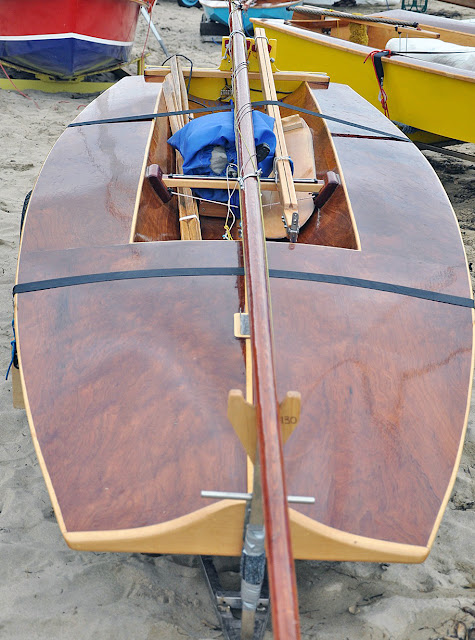As promised in a previous post, Andrew Chapman sent over a slew of photos taken by Tim Wilson of the 2016 Aussie Classic Wooden Dinghy Regatta. Inverloch, where the regatta is held, is the home of the Australian scow Moth (Len Morris with his
Olive - 1927) and at this year's regatta there was a good turnout in the scows.
Andrew lists the scow Moths competing;
The Moths are as follows:
- Phillip Johnson's ‘Frolic’ [was] built in the early 60s.
- Jim French’s ‘Skeeta’ [is] a 1965 boat. Jim is a fairly famous Moth builder and sailor and is the person who developed the scow on foils.
- My ‘Blondie’ - about early 60s or could be late 50s. The sail numbers do not necessarily indicate a clear progression in design.
- Jonathan Parise’s 1970s ‘Red’ is a winged Western Australian boat. A beautiful boat to sail and Jonathan is just learning to sail it and loving every minute.
- Mark’s [Rimington] Maggie, which you know a bit about.
- Graham Cooper’s unnamed boat that does not have a sail number. Its design is very similar to ‘Blondie’.
- Matt Kiely’s ‘Street Fighter’ which is another Western Australian boat. Like ‘Red’ it is very light and quick.
The photos:
Andrew Chapman's
Blondie.
Photo courtesy of Tim Wilson
Matt Kiely on
Street Fighter.
Photo courtesy of Tim Wilson
Maggie was a 2015 build of the classic Imperium design and was featured in last year's Earwigoagin post on the Classic Wooden Dinghy Regatta.
Photo courtesy of Tim Wilson
Scows launching. The
Mouldie in the foreground.
Photo courtesy of Tim Wilson
The
Mouldie or Peter Cole designed Mouldie. They were built with super-thin veneers and thousands of staples. The restoration of this one entailed regluing a fair amount of the veneer back in place.
Photo courtesy of Tim Wilson
The
Mouldie under sail. Look at that snout!
Photo courtesy of Tim Wilson
The winged
Red.
Photo courtesy of Tim Wilson
Photo courtesy of Tim Wilson
Street Fighter rounding a mark.
Photo courtesy of Tim Wilson
Photo courtesy of Tim Wilson
Mike Scott, the Brit who spent his young adult life in Australia, continues his Down Under saga retelling his time in the Aussie scow Moth (dragged over from the comments section);
"Ah, memories.......after crewing Sharpies on Lake Illawarra, I moved to Sydney to work at Miller and Whitworth's new chandlery and boat store at Rochdale, where we sold the De Havilland Marine built, Alan Payne designed range of fibreglass boats - the 16ft Corsair, 12ft Vagabond, and the 10ft Gypsy.
During this time I built my first boat from a kit - a Cole scow Moth, with not much more than a Black and Decker drill and a stapler. Loved it - so fast, couldn't believe the acceleration....sailed it on Botany Bay, and at Connels Point Sailing Club just inside the Georges River. Used to get regularly beaten by the 14 yr old kids - Aussie kids in those days were super fit from swimming and surfing.













